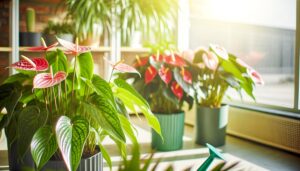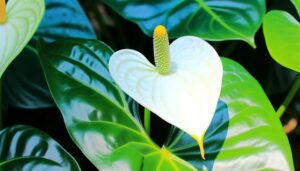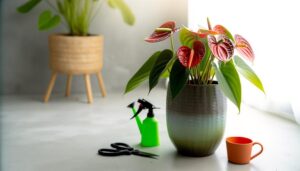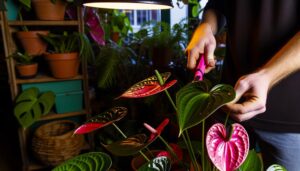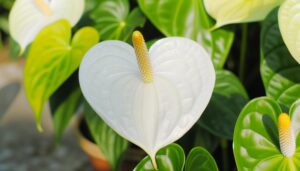Caring for Anthurium Livium Red: A Complete Guide
Proper care for Anthurium Livium Red involves providing bright, indirect light, ideally from an eastern or northern window. Water when the top inch of soil feels dry to maintain even moisture, but avoid overwatering to prevent root rot.
Maintain high humidity (70-80%) and temperatures between 65-80°F (18-27°C). Use a well-draining soil mix rich in organic matter and a clay or terracotta pot with drainage holes.
Fertilize bimonthly with a balanced 20-20-20 NPK ratio, supplemented with magnesium and calcium. Monitor for pests and common problems like leaf browning and root health, adjusting care as needed for best growth.
For more in-depth guidance, continue exploring the specifics.
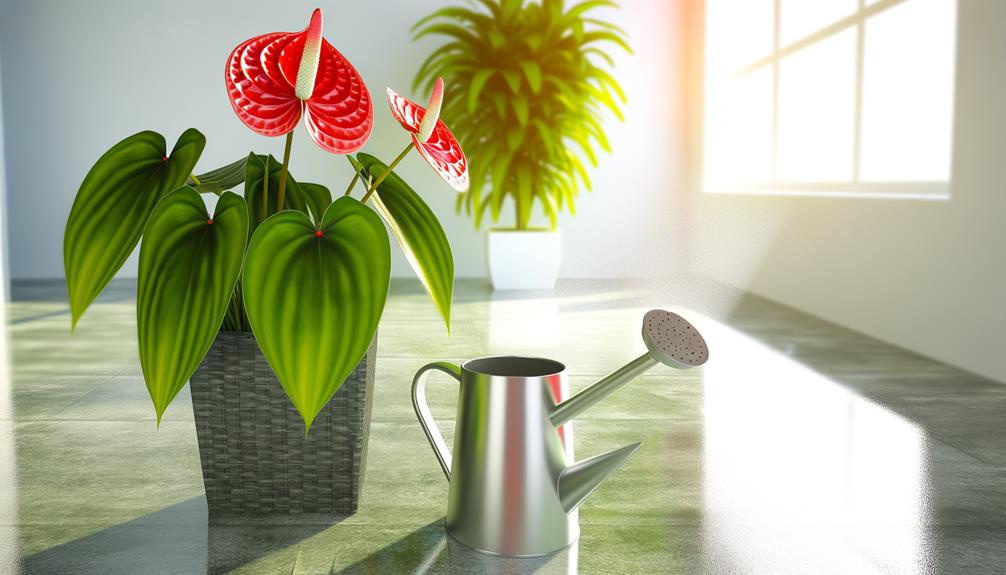
Key Takeaways
- Place Anthurium Livium Red in bright, indirect light near an east or north-facing window.
- Water when the top inch of soil feels dry and ensure proper drainage to avoid root rot.
- Maintain high humidity levels between 70-80% and temperatures between 65-80°F (18-27°C).
- Use a well-draining soil mix rich in peat moss, pine bark, and perlite.
- Apply balanced fertilizers bimonthly and supplement with micronutrients like magnesium and calcium.
Light Requirements
To maximize expansion, Anthurium Livium Red requires bright, indirect light. Position the plant near an east or north-facing window, where it can receive diffused sunlight for 6-8 hours daily. Direct sunlight should be avoided as it can cause leaf scorch, characterized by brown, crispy edges.
Utilize sheer curtains or light-filtering blinds to mitigate light intensity. In environments with limited natural light, full-spectrum fluorescent bulbs can be used, maintaining a distance of 18-24 inches from the plant. Monitor the foliage color; dark green leaves may indicate insufficient light, whereas yellowing signifies excess light.
Adjust positioning accordingly to ensure peak photosynthetic activity, fostering robust growth and vibrant coloration in the Anthurium Livium Red.
Watering Schedule
Maintaining a consistent watering schedule is important for the health and vigor of Anthurium Livium Red. This tropical plant thrives in evenly moist, well-drained soil. Water the plant thoroughly when the top inch of soil feels dry to the touch. Overwatering can lead to root rot, so make sure the pot has adequate drainage. Use lukewarm, dechlorinated water to prevent shock to the roots.
During the growing season, typically spring through early autumn, more frequent watering may be necessary. Conversely, reduce watering frequency in the dormant winter months. Regularly monitor the plant's moisture levels and adjust accordingly. Proper hydration is vital for sustaining the Anthurium's vibrant foliage and prolific flowering capabilities, ensuring ideal growth and longevity.
Humidity Needs
Anthurium Livium Red requires high moisture levels, typically between 70-80%, to thrive and produce its characteristic vibrant foliage. High moisture mimics the plant's natural tropical habitat and supports optimal cellular function. Lower moisture can lead to browning leaf tips and stunted growth. Utilizing a hygrometer can help monitor indoor moisture levels accurately. Employing a humidifier or placing the plant on a pebble tray with water are effective methods to maintain the required moisture.
| Method | Description |
|---|---|
| Humidifier | Device that adds moisture to the air |
| Pebble Tray | Tray with water and pebbles to increase moisture |
| Grouping Plants | Placing plants together to create a microclimate |
Regularly misting the leaves can also provide temporary moisture boosts.
Temperature Preferences
Consistently, the top temperature range for Anthurium Livium Red is between 65-80°F (18-27°C) to promote healthy growth and vibrant foliage. This temperature range mimics the plant's native tropical environment, ensuring prime physiological processes.
It is essential to avoid temperatures below 60°F (15°C) as prolonged exposure can lead to reduced metabolic activity and potential cold damage. Conversely, temperatures exceeding 85°F (29°C) can cause heat stress, which manifests as wilting or leaf burn.
Maintaining stable temperatures is vital; sudden fluctuations can disrupt growth patterns. Position the Anthurium away from drafty windows or direct heat sources to prevent temperature shocks. Utilizing a thermometer to regularly monitor the ambient temperature guarantees that the plant remains within its ideal range.
Soil Mix
To maximize development, a well-draining soil mix rich in organic matter is essential for Anthurium Livium Red. This plant thrives in a medium that mimics its natural habitat, promoting root aeration and moisture retention. A blend incorporating peat, pine bark, and perlite provides the ideal balance. Peat moss retains moisture, essential for the plant's hydration, while pine bark and perlite promote proper drainage and prevent root rot. The table below summarizes the recommended soil components and their respective functions.
| Component | Function |
|---|---|
| Peat Moss | Moisture retention |
| Pine Bark | Aeration and structure |
| Perlite | Drainage enhancement |
| Charcoal | Toxin absorption |
Regularly check the soil's consistency and adjust the mix as needed to maintain best conditions for healthy growth.
Fertilizing Tips
When fertilizing Anthurium Livium Red, it is essential to utilize a balanced, water-soluble fertilizer with a ratio of 20-20-20 for best nutrient uptake. Application should be carried out every four to six weeks during the active growing season, ensuring the plant receives consistent nourishment.
Additionally, reducing the concentration to half the recommended strength can prevent potential nutrient burn.
Best Fertilizer Types
Selecting the appropriate fertilizer for Anthurium Livium Red is crucial for promoting vibrant blooms and healthy foliage. For optimal growth, consider fertilizers that provide a balanced mix of macronutrients and micronutrients. Water-soluble fertilizers are particularly effective, as they ensure nutrients are readily available for uptake.
Here are critical characteristics of ideal fertilizers for Anthurium Livium Red:
- Balanced N-P-K Ratio: A balanced ratio, such as 20-20-20, guarantees even nutrient distribution.
- Micronutrient Inclusion: Essential trace elements like iron, magnesium, and calcium support robust plant health.
- Slow-release Formulations: These offer a steady nutrient supply over time.
- Urea-free Options: Reduces the risk of root burn and foliage damage.
- Organic Fertilizers: Enhance soil health and microbial activity, promoting long-term plant well-being.
Application Frequency
Consistency in fertilization is vital for the thriving growth of Anthurium Livium Red. Best nutrient intake is achieved through a regular fertilization schedule. It is advisable to fertilize every 6-8 weeks during the growing season (spring and summer) and reduce frequency during dormancy (fall and winter). A balanced, water-soluble fertilizer with a 20-20-20 NPK ratio is recommended.
| Season | Frequency |
|---|---|
| Spring | Every 6-8 weeks |
| Summer | Every 6-8 weeks |
| Fall/Winter | Every 10-12 weeks |
Adjustment based on plant response is essential. Observe for signs of over-fertilization, such as leaf burn or salt buildup. Diluting the fertilizer to half-strength can mitigate potential adverse effects, ensuring sustained plant health without nutrient overload.
Pruning and Maintenance
Proper pruning and maintenance of Anthurium Livium Red are crucial for promoting healthy growth and vibrant blooms. Regular attention to these tasks can prevent disease and encourage robust development. Pruning should be conducted using sterilized tools to minimize the risk of infection. Focus on removing dead or yellowing leaves, spent flowers, and any stems that appear leggy or weak.
Key maintenance practices include:
- Regularly inspect for pests and diseases.
- Maintain high humidity levels to support foliage health.
- Guarantee proper air circulation to prevent fungal growth.
- Fertilize monthly during the growing season with a balanced, water-soluble fertilizer.
- Avoid overwatering by allowing the soil surface to dry slightly between waterings.
These steps will ensure your Anthurium Livium Red remains a striking feature in your collection.
Repotting Guide
When repotting Anthurium Livium Red, selecting an appropriate pot size is essential to ensuring adequate root development and preventing waterlogging.
Utilize a well-draining soil mix, rich in organic matter, to facilitate ideal nutrient uptake.
Additionally, incorporate balanced fertilizers to maintain essential nutrient levels and promote healthy growth.
Choosing Appropriate Pot
Selecting the appropriate pot for repotting Anthurium Livium Red involves understanding the plant's root system and ensuring adequate drainage to prevent waterlogging. The pot size should accommodate root growth without allowing excess space that could retain water. Materials like clay or terracotta are preferred due to their breathable nature, promoting healthy aeration. Confirm the pot has sufficient drainage holes to prevent root rot, a common issue in waterlogged conditions.
Key considerations for choosing the pot include:
- Size: Slightly larger than the current pot, allowing room for growth.
- Material: Clay or terracotta for breathability.
- Drainage: Multiple drainage holes at the bottom.
- Shape: Wider rather than deeper to support shallow root systems.
- Stability: Weighted base to prevent tipping over.
Soil and Nutrients
After selecting a suitable pot, the next critical step involves choosing the right soil blend and understanding the nutrient requirements for Anthurium Livium Red to guarantee ideal growth and health. Employ a well-draining, aerated soil mix rich in organic matter. A recommended blend includes peat moss, pine bark, and perlite, ensuring adequate moisture retention without waterlogging.
Nutrient-wise, Anthurium Livium Red flourishes with balanced, slow-release fertilizers applied bimonthly. An N-P-K ratio of 20-20-20 is effective, supplemented with micronutrients like magnesium and calcium. During repotting, gently remove excess soil from roots, and inspect for rot or pests. Fill the new pot with the prepared soil mix, ensuring the plant sits at the same depth as before.
Common Problems
Anthurium Livium Red may encounter several common problems, including root rot, pest infestations, and nutrient deficiencies, which necessitate careful monitoring and timely intervention.
Root rot often arises from waterlogged soil; ensuring well-draining soil can mitigate this risk.
Pest infestations, such as those by aphids or spider mites, require prompt treatment with appropriate insecticides.
Nutrient deficiencies, particularly of magnesium or iron, manifest as chlorosis and necessitate balanced fertilization.
- Root Rot: Prevent by using well-draining soil and avoiding overwatering.
- Pest Infestations: Regularly inspect for aphids, spider mites, and treat with insecticides.
- Nutrient Deficiencies: Supplement with balanced fertilizers to prevent chlorosis.
Leaf browning often occurs due to low humidity; increasing ambient moisture can help.
Wilting may indicate issues with watering practices or root health, so it's important to check both carefully.
Conclusion
Just as a well-tuned orchestra requires each instrument to perform in harmony, the best care for Anthurium livium red demands the precise balance of light, water, humidity, temperature, and nutrients.
Neglecting any one aspect can disrupt the plant's overall health, much like a missed note in a symphony.
By following the detailed guidelines provided, one can guarantee that this vibrant species flourishes, yielding its characteristic red blooms and lush foliage as a proof of meticulous horticultural practice.

